BioShock theme by DavePro65
Download: Bioshock_5.p3t
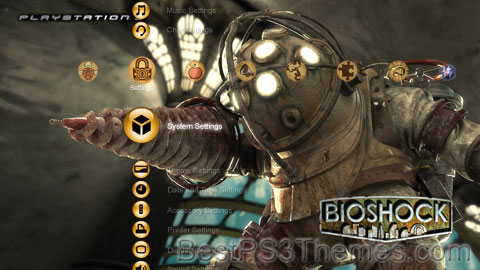
(1 background)
| BioShock | |
|---|---|
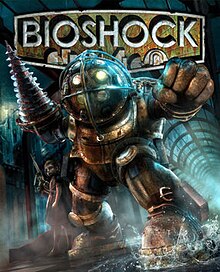 | |
| Developer(s) | |
| Publisher(s) | 2K |
| Director(s) | Ken Levine |
| Designer(s) | Paul Hellquist |
| Programmer(s) |
|
| Artist(s) | Scott Sinclair |
| Writer(s) | Ken Levine |
| Composer(s) | Garry Schyman |
| Series | BioShock |
| Engine | Unreal Engine 2.5[4] |
| Platform(s) | |
| Release | |
| Genre(s) | First-person shooter |
| Mode(s) | Single-player |
BioShock is a 2007 first-person shooter game developed by 2K Boston (later Irrational Games) and 2K Australia, and published by 2K. The first game in the BioShock series, it was released for Microsoft Windows and Xbox 360 platforms in August 2007; a PlayStation 3 port by Irrational, 2K Marin, 2K Australia and Digital Extremes was released in October 2008. The game follows player character Jack, who discovers the underwater city of Rapture, built by business magnate Andrew Ryan to be an isolated utopia. The discovery of ADAM, a genetic material which grants superhuman powers, initiated the city's turbulent decline. Jack attempts to escape Rapture, fighting its mutated and mechanical denizens, while engaging with the few sane survivors left and learning of the city's past. The player can defeat foes in several ways by using weapons, utilizing plasmids that give unique powers, and by turning Rapture's defenses against them.
BioShock's concept was developed by Irrational's creative lead, Ken Levine, and incorporates ideas by 20th century dystopian and utopian thinkers such as Ayn Rand, George Orwell, and Aldous Huxley, as well as historical figures such as John D. Rockefeller Jr. and Walt Disney. The game includes role-playing elements, giving the player different approaches in engaging enemies such as by stealth, as well as moral choices of saving or killing characters. Additionally, the game borrows concepts from the survival horror genre, notably the Resident Evil series. BioShock is considered a spiritual successor to the System Shock series, on which many of Irrational's team, including Levine, had worked previously.
BioShock received universal acclaim and was particularly praised by critics for its narrative, themes, visual design, setting, and gameplay. It is considered to be one of the greatest video games ever made and a demonstration of video games as an art form. BioShock was followed by two sequels, BioShock 2 and BioShock Infinite, released in 2010 and 2013, respectively. Ports of BioShock were released for macOS and mobile following its console releases. A remastered version of the game was released on Microsoft Windows, PlayStation 4, Xbox One, and Nintendo Switch as part of BioShock: The Collection.
Synopsis[edit]
Setting[edit]
BioShock takes place in Rapture,[5][6] a large underwater city planned and constructed in the 1940s by individualist business magnate Andrew Ryan, who wanted to create a utopia for society's elite to flourish outside of government control and "petty morality". This philosophy resulted in remarkable advances in the arts and sciences, which included the discovery of "ADAM": a potent gene-altering substance which is created by a species of sea slug on the ocean floor. ADAM led to the creation of "Plasmids", mutagenic serums that grant users super-human powers such as telekinesis and pyrokinesis. To protect and isolate Rapture, Ryan outlawed any contact with the surface world.[7]
As Rapture flourished, wealth disparities grew, and criminal Frank Fontaine used his influence over the disenfranchised working class to establish illegal enterprises and obtain power—enough to rival Ryan. With doctors Brigid Tenenbaum and Yi Suchong, Fontaine created his own company dedicated to researching plasmids and gene tonics. As ADAM became addictive and demand skyrocketed, Fontaine secretly mass-produced ADAM through slugs implanted in the stomachs of orphaned girls, nicknamed "Little Sisters". Fontaine was killed in a shootout with police, and Ryan took the opportunity to seize his assets, including control of the Little Sisters.
In the months that followed, a man amongst the poor named Atlas rose up and began a violent revolution against Ryan, with both sides using plasmid-enhanced humans (known as "Splicers") to wage war on one another. To protect the Little Sisters, Ryan created the "Big Daddies": genetically enhanced humans surgically grafted into gigantic lumbering diving suits designed to escort the sisters as they scavenged ADAM from dead bodies.[5] Tensions came to a head on New Year's Eve of 1958 when Atlas ordered an all-out assault on Ryan and his supporters. The conflict turns Rapture into a war-torn crumbling dystopia, resulting in societal collapse, countless deaths, many Splicers becoming disfigured and insane from ADAM abuse, and the few sane survivors barricading themselves away from the chaos.[8]
Plot[edit]
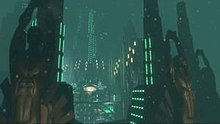
In 1960, the protagonist, Jack, is a passenger on a plane that crashes in the Atlantic Ocean.[10][11] The only survivor, Jack makes his way to a nearby lighthouse; inside is a bathysphere that takes him to Rapture.[12] Jack is contacted via radio by Atlas, who helps guide him through the ruined city.
Atlas requests Jack's help in saving his family, who he says are in a docked bathysphere. When Jack first encounters the Little Sisters, Atlas urges him to kill them to harvest their ADAM. Dr. Brigid Tenenbaum intervenes and insists Jack should spare them, providing him with a plasmid that can remove the sea slug from their bodies and free them of their brainwashing.[13] Jack works his way to the bathysphere, but Ryan destroys it before Jack can reach it. Infuriated, Atlas has Jack fight his way through various districts toward Ryan's lair, forcing Jack to contend with Rapture's deranged citizens along the way, such as the surgical doctor J.S. Steinman and artist and musician Sander Cohen.
Jack enters Ryan's office. Ryan reveals the truth of Jack's origins: he is actually Ryan's illegitimate son, sold by Ryan's mistress as an embryo to Fontaine, who had Tenenbaum and Suchong rapidly age Jack into adulthood and turned into an obedient assassin, capable of accessing any of Rapture's systems locked to Ryan's genetic code and thus ensure Fontaine's victory in the war. Jack was smuggled to the surface with false memories of a normal life, waiting to be called back to Rapture when needed. Ryan takes control of Jack's actions by asking, "Would you kindly?"; a phrase that has preceded many of Atlas' commands as a hypnotic trigger, forcing him to follow any orders without question. Jack also realizes he was responsible for the plane crash, having read a letter onboard containing the same trigger phrase.[14]
Ryan chooses to die by his own will and compels Jack to beat him to death with a golf club. Atlas reveals himself to be Fontaine, having faked his death and used "Atlas" as an alias to hide his identity while providing a heroic figure for the poor to rally behind. With Ryan dead, Fontaine takes control of the city and leaves Jack to be killed by hostile security drones. Jack is saved by Dr. Tenenbaum, who helps remove Fontaine's mental conditioning, including one that would have stopped Jack's heart. Jack pursues Fontaine to his lair, where Fontaine transforms himself into a hulking humanoid creature by injecting himself with a large supply of ADAM. The Little Sisters aid Jack in draining the ADAM from Fontaine's body and eventually kill him.
The ending depends on how the player interacts with the Little Sisters:
- If the player rescues all or all but one of the Little Sisters, Jack takes them back to the surface with him and adopts five of them as his daughters. Tenenbaum happily narrates how they go on to live full lives under his care, eventually surrounding him on his deathbed. This ending is considered canon in BioShock Infinite: Burial at Sea.
- If the player harvests more than one Little Sister, Jack turns on the Little Sisters to harvest their ADAM.[15] Tenenbaum sadly narrates what occurs, condemning Jack and his actions. A submarine comes across the plane's wreckage and finds itself surrounded by bathyspheres containing Splicers, who attack the crew and take control of it. The submarine is revealed to be carrying nuclear missiles, with Tenenbaum claiming that Jack has "stolen the terrible secrets of the world":[16] The more Little Sisters Jack harvests throughout the game, the harsher and more furious Tenenbaum's narrative becomes.[17]
Gameplay[edit]
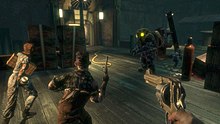
BioShock is a first-person shooter with role-playing customization and stealth elements, and is similar to System Shock 2. The player takes the role of Jack as he is guided through Rapture towards various objectives. The player collects multiple weapons and plasmids as they work their way through enemy forces. The player can switch between one active weapon and one active plasmid at any time, allowing them to find combination attacks that can be effective against certain enemies, such as first shocking a Splicer then striking them down with a wrench. Weapons are limited by ammunition that the player collects; many weapons have secondary ammo types that can be used instead for additional benefits, such as bullets that inflict fire damage. Plasmid use consumes a serum called EVE which can be restored using EVE syringes collected by the player or by consuming cigarettes and alcohol.[18] The player has a health meter that decreases when they take damage. The player can restore their health with food or medical packs found throughout Rapture. If the player's health is reduced to zero, they will be regenerated at the last Vita-Chamber that they passed with limited amounts of health and EVE. A patch for the game allows the Vita-Chambers to be turned off, requiring players to restart a saved game if the character dies.[19]
The game provides several options to face challenges. In addition to direct combat, the player can use plasmids to lure enemies into traps or to turn enemies against each other, or employ stealth tactics to avoid detection by hostiles including the security systems and turrets.[20] The player can hack into any of Rapture's automated systems; the hacking process is done via a mini-game similar to Pipe Mania where the player must connect two points on opposite sides of a grid with a limited set of piping within a fixed amount of time, with failure to complete in time costing health and potentially sounding alarms.[21][22] Early in the game, the player is given a research camera; by taking photographs of enemies, the player will cumulatively gain knowledge about the individual foes which translates into attack boosts and other benefits when facing that enemy type in the future.[23]
The player collects money by exploring Rapture and from the bodies of defeated foes; this money can be used at vending machines to restock on ammunition, health and EVE, and other items; like security cameras, vending machines can be hacked to reduce the costs of items from it.[22] The player will receive rewards in the form of ADAM from completing some tasks, as well as from either saving or killing the Little Sisters after defeating their Big Daddy guardian. ADAM is used to purchase plasmids from Gatherer's Garden machines scattered around Rapture.[24] In addition to plasmids, the player can collect and buy tonics that provide passive bonuses, such as increasing Jack's strength, using EVE more efficiently, or making Jack more resistant to damage. The player can only have a limited number of plasmids and tonics active at any time, and can swap between the various plasmids and tonics at certain stations located throughout Rapture.[5]
Development[edit]
Game design[edit]
Lead developer Ken Levine had created Irrational Games in 1997 out of former members from Looking Glass Studios.[25][26] Their first game was System Shock 2, a sequel to Looking Glass's System Shock, and was met with critical success, though it did not prove a financial one. Levine had attempted to pitch a sequel to System Shock 2 to Electronic Arts, but the publisher rejected the idea based on the poor performance of the earlier game.[27] Irrational developed other games, including Freedom Force, Tribes: Vengeance, the canceled title Deep Cover, and the completed The Lost which was never released due to legal complications. At this point, Levine wanted to return to a game in the same style as System Shock 2, a more free-form game with strong narrative.[27][28]
In 2002, the team had come up with a core gameplay mechanic idea based on three groups of forces; drones that would carry a desirable resource, protectors that would guard the drones, and harvesters that would attempt to take the resource from the drones; these would eventually bear out as the Little Sisters, Big Daddies, and Splicers in the final game, but at the time of the concept, there was no set theme.[28] They began working on creating a setting as to be able to pitch the idea to publishers.[28] A 2002 demonstration version was based on the Unreal Engine 2 for the Xbox.[27] This demonstration was primarily set aboard a space station overtaken with genetically mutated monsters; the main character was Carlos Cuello, a "cult deprogrammer"—a person charged with rescuing someone from a cult, and mentally and psychologically readjusting that person to a normal life.[27][29] Ken Levine cites an example of what a cult deprogrammer does: "[There are] people who hired people to [for example] deprogram their daughter who had been in a lesbian relationship. They kidnap her and reprogram her, and it was a really dark person, and that was the [kind of] character that you were."[30] This story would have been more political in nature, with the character hired by a Senator.[30] The team collectively agreed that this game was not what they had set out to make, and were having trouble finding a publisher.[27] They considered ending development, but as news about their efforts to create a spiritual successor to System Shock 2 began to appear in gaming magazines and websites, the team opted to continue development, performing a full revamp.[27]
By 2004, 2K Games, a subsidiary of Take-Two Interactive, offered to publish the game primarily based on the drone/protector/harvester concept, giving Irrational the freedom to develop the story and setting.[28][31][32] By this point, the story and setting had changed significantly, taking place in an abandoned World War II-era Nazi laboratory that had been recently unearthed by 21st-century scientists. Over the decades, the genetic experiments within the labs had gradually formed themselves into an ecosystem centered on the three groups.[33] This version included many of the gameplay elements that would remain in the final BioShock, themselves influenced by concepts from System Shock 2. These elements included the use of plasmids and EVE, the need to use stealth or other options to deal with automated security systems, direction through the environment from a non-player character relayed over a radio, and story elements delivered through audio recordings and "ghosts" of deceased characters.[34][35][36]
While the gameplay with the 2004 reveal was similar to what resulted in the released version of BioShock, both design and story changed, consistent with what Levine says was then-Irrational Games' guiding principle of putting game design first.[29] These areas were also issued due to some internal strife and lack of communication between the various teams within Irrational, part of the result of having to expand the team from six to sixty members for the scope of the project.[27] The environment was considered bland, and there were difficulties by the team's artists to come up with a consistent vision to meet the level designer's goals.[27] A critical junction was a short experiment performed by level designer Jean Paul LeBreton and artist Hoagy de la Plante, setting themselves aside to co-develop a level that became part of the "Tea Garden" area in the released game, which Levine used as a prime example of a "great BioShock space", emphasizing the need for departments to work together.[27] Levine found that the cyberpunk theme had been overplayed considering their initial reject from Electronic Arts for System Shock 3, leading towards the underwater setting of Rapture.[27]
The game's lead level designer was Bill Gardner.[37] He cited Capcom's survival horror series Resident Evil as a significant influence on BioShock, stating there are "all these nods and all these little elements that I think you can see where Resident Evil inspired us". The team were particularly influenced by Resident Evil 4, including its approach to the environments, combat, and tools, its game design and tactical elements, its "gameplay fuelled storytelling" and inventory system, and its opening village level in terms of how it "handled the sandbox nature of the combat" and in terms of "the environment".[38]
Story and theme development[edit]
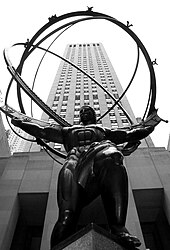
The thematic core of BioShock was born when Levine was walking at Rockefeller Center near the GE Building in New York City. He saw the uniqueness of the art deco styling of the building along with imagery around the building such as the statue of Atlas near it, and recognized that these were spaces that had not been experienced in the first-person shooter genre.[28] The history of the Rockefeller Center also fed into the story concept; Levine noted how the center had started construction prior to the Great Depression; when the primary financiers had pulled out, John D. Rockefeller Jr. backed the remaining construction to complete the project himself, as stated by Edge magazine "a great man building an architectural triumph against all the odds".[28] The history of Rapture and the character of Andrew Ryan is loosely based on Rockefeller's story.[28] He also considered that many of the characters of Rapture were all people who were oppressed once before in their lives and now free of that oppression, have turned around and become the oppressors, a fact he felt resonated throughout human history.[39]
At this point in the development, the backdrop of Rapture had been fleshed out, but they had yet to come on how to represent the drones, protectors, and harvesters from their original game idea. The Big Daddy concept as the protector class was developed early in the process, but the team had yet to reach a satisfying design for the drones, having used several possible designs including bugs and dogs in wheelchairs.[28] The team wanted to have the player care for the drones in some way and create pathos for these characters. The idea of using little girls came out of brainstorming, but was controversial and shocking within the team at first, recognizing that they could easily be killed and make the game more horrific in the style of Night Trap.[28] However, as Levine worked on the story, he started to incorporate the ideas of dystopian and utopian thinkers from the twentieth century, including Ayn Rand, Aldous Huxley, and George Orwell, and considered their ideas "fascinating".[40] He brought in the ideas of Objectivism that Rand primarily outlined in the book Atlas Shrugged, that man should be driven by selfishness and not altruism, and used this to inform the philosophy behind the city of Rapture and Andrew Ryan's work, viewing them as quite ludicrous, and primed to be applied to an antagonist, tied in with his previous observations on Rockefeller and his writings.[28] This was extended to the use of the little girls as drones (now Little Sisters), particularly the question whether the player should try to save the girls or harvest the ADAM for their benefit.[28] 2K Games expressed concern about the initial mechanic of the Little Sisters, where the player would actively prey on the Little Sister, which would have alerted a Big Daddy and set up the fight with the player. This approach did not sit well with Levine, and 2K Games asserted that they would not ship a game "where the player gets punished for doing the right thing".[27] They altered this approach where the Little Sisters would be invulnerable until the player had dealt with their Big Daddy, though LeBreton considered this "a massive kludge" into the game's fiction.[27][28] The idea of creating the Little Sisters and presenting the player with this choice became a critical part of the game's appeal to the broader gaming market, although it was met with criticism from some outlets.[28] Levine desired only to have one ending to the game, something that would have left the fate of the characters "much more ambiguous", but publisher pressure directed them to craft multiple endings depending on the choice of harvesting Little Sisters.[39] Levine also noted that "it was never my intention to do two endings for the game. It sort of came very late and it was something that was requested by somebody up the food chain from me."[41]
Other elements came into the story design. Levine had an interest in "stem cell research and the moral issues that go around [it]".[40] Regarding artistic influences, Levine cited the books Nineteen Eighty-Four and Logan's Run, representing societies that have "really interesting ideas screwed up by the fact that we're people".[42] The idea of the mind control used on Jack was offered by LeBreton, inspired by films like The Manchurian Candidate, as a means to provide a better reason to limit the player's actions as opposed to the traditional use of locked doors to prevent them exploring areas they should not. The team had agreed that Jack's actions would be controlled by a key phrase but struggled with coming up with one that would not reveal Atlas' true nature. Levine happened upon "Would you kindly" after working on marketing materials for the game that asked the reader hypothetical questions such as "Would you kill people, even innocent people, to survive?", later working that phrase into the first script for the game.[27]
Numerous tensions within the team and from publisher 2K Games continued during the development process. According to LeBreton, Levine was distrustful of some of the more egotistical newer hires and was often arguing with them to enforce his vision of BioShock.[27] 2K Games was concerned with the growing budget for the title, and told Levine to market the title more as a first-person shooter rather than the first-person shooter/role playing game hybrid they set out for.[27] Near the targeted release date, Levine ordered the team into round-the-clock development, creating more strife in the team.[27] Paul Hellquist, the game's lead designer, was often omitted from key design meetings, which he later recounted was due to his contrary nature to Levine, questioning several of his choices; he used his frustration to put into the design efforts for the Medical Pavilion level that he was in charge of at that time.[27] Near the anticipated completion date, 2K decided to give Irrational another three months to polish up the game, extending the current crunch time the studio was already under.[27] This left some hard-to-discover bugs and issues in the game undiscovered. One such case was an apparent Easter egg found in the remastered version in 2018, where under certain conditions, the player can end up looking at an object with the description "Paul Hellquist did not do his Job". Both Levine and Chris Kline, the game's lead programmer confirmed the message was a cheeky jab at Hellquist left as a debugging message; Kline and Hellquist were developing the systems to show descriptions of objects to players when looked at, and Hellquist offered to complete all the necessary descriptions in-game; to jokingly help prod Hellquist along, Kline put "Paul Hellquist did not do his Job" as the default message within the executable code. While the code message was changed for the original release, the remastered version likely used a pre-final version of the BioShock code, according to Kline.[43] Hellquist took the revelation in good humor and tweeted that other Easter eggs should have been added to the game to display: "If you are enjoying this, Paul Hellquist did his job."[44]
A critical playtest of the game occurred in January 2007, where initial feedback from the players was mostly negative, including issues of the setting being too dark, having no idea where to go, and distrusting Atlas, who at the time was voiced in a southern drawl, described as a "lecherous Colonel Sanders".[27] The team took this criticism to heart, revamping several elements during those extra months such as improving the lighting, implementing a quest marker, and using an Irish voice for Atlas to make him sound more trustworthy.[27] During another late-stage playtest with the title "ninety-nine percent" complete according to Levine, the playtesters did not like the game at all as they felt no connection to the player-character Jack, and the person overseeing the tests told Levine that the game was likely to be a failure. At this point, BioShock did not have many cutscenes, as Levine was ideologically opposed to them. However, the following day, Levine and the lead group came up with a "cheap" way to correct this, by adding the initial cut scene within the plane and the subsequent plane crash, as this helped to set the time frame, place the player in the role of the character, and alluded to the "would you kindly" line later in the game.[39] Levine likened this approach to the initial aircraft crash at the onset of the television show Lost to quickly establish character and setting.[28]
The game was successfully released in August 2007 with a final budget of about $25 million.[27] In a 2016 interview, Levine felt that the game could have used about six more months of development to improve the gun combat system and fix lagging issues that occurred during the final boss fight.[39] Despite the critical success of the title, many of those on the team would leave Irrational to pursue other projects due to late development strife that occurred.[27]
In an interview in 2018, Levine had come to recognize that BioShock reflected several Jewish themes, though this was not intentional. Levine, who considers himself culturally Jewish but does not follow Judaism, had grown up in New Jersey but spent much of his childhood time with his father who worked in Manhattan's Diamond District and visiting his grandparents in Queens, a neighborhood with a large proportion of Eastern European immigrants. Thus, Levine was exposed to much of the Jewish culture that flourished in the area following World War II and understood some of the anxiety Jewish people faced.[45] In the 2018 interview, Levine recognized several of the characters, including Andrew Ryan (who was inspired by Ayn Rand who was also Jewish), Sander Cohen, and Brigid Tenenbaum, were written all as Jewish, and all seeking to escape a world they felt they did not fit into by going to Rapture; Levine said: "'There's literal displacement and then there's a feeling of not fitting in, of 'I don't really belong here'. I think Jews are always going to feel a little bit like they don't belong wherever they are. There's always that 'what if we have to flee' mentality."[45]
Game engine[edit]
BioShock uses a heavily modified Unreal Engine 2.5 with some of the advanced technologies from Unreal Engine 3.[4] Irrational had previous experience with modifying and expanding on the Unreal Engine in SWAT 4, and continued this advancement of the engine within BioShock. One significant improvement they added was improved water effects, given the nature of the game's setting, hiring a programmer and artist to focus on the water effects.[46] This graphical enhancement has been lauded by critics, with GameSpot saying: "Whether it's standing water on the floor or sea water rushing in after an explosion, it will blow you away every time you see it."[47] BioShock also uses the Havok Physics engine that allows for an enhancement of in-game physics, the integration of ragdoll physics, and allows for more lifelike movement by elements of the environment.[48] The Windows version was built to work in both Direct3D 10 (DirectX 10) and DirectX 9, with the DirectX 10 version supporting additional water and par
One Reply to “BioShock #5”
Comments are closed.

The majority of the icons are derived from the “Gorgeous Flame” theme – so big thanks to Tarot P. Turcato (aka PulseDragon).
This set includes both SD and HD backgrounds.
Enjoy!